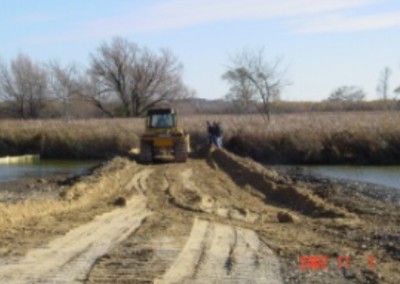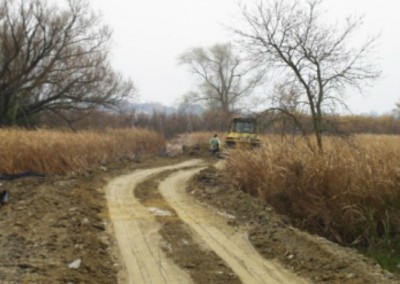Pape Island
BIO-ENGINEERED SHORELINE STABILIZATION
LOCATION: McHenry, IL. Pistakee Lake. PARTNERS: Illinois Dept of Natural Resources, US Army Corps Engineers-CHGO, US Fish and Wildlife, Lake Co Stormwater, Lake Co Planning & Development and McHenry County P&D. FUNDING: IL Capital Bond Funds (IDNR) and User Fees (FWA). PROJECT DESIGN / CONSTRUCTION:V3 Consultants, V3 Construction and FWA staff. COMPLETION DATE: 2004. COST: $1.2M.
Pape Island is immediately adjacent to the main navigational boating channel for boats traveling north and south between the lakes of the Chain O’Lakes and the Fox River. Excessive wave activity caused both by boating and wind fetch across Pistakee Lake had caused severe erosion of the Pape Island shoreline. Other unique strains to the island are ice floes and stacking, ice expansion and an annual eighteen-inch plus winter drawdown.
In 2001, in collaboration with over 17 Federal, State and local partners, V3 Consultants was hired to do a comprehensive evaluation of alternative bio-engineered bank stabilization measures. Comparative effectiveness for shoreline stabilization of the island was established with respect to the following parameters: high wave action due to wind fetch and high boat traffic, icing in the winter, high flood flows during spring and early summer months, and an eighteen-inch drop in water elevation due to winter draw down procedures. Five stabilization methods were ultimately chosen, as follows:
Joint Planting: Method consisted of a fortified rip-rap toe and base with both an emergent planting zone interspersed with live stake woody planting zones.
Vegetated Gabion Basket: Method consisted of vegetated gabion baskets surrounding the rip-rap rock toe and base with both an additional emergent planting zones and live stake woody planting zones.
Log and Rootball Revetment: Method is similar to joint planting with the addition of buried log tree trunks with root balls structures directed towards the lake. These root balls provide a physical break to the wave action before it reaches the shoreline while also providing habitat benefits for fish, small animals and aquatic insects.
Lunker Structure: Method is similar to the joint planting method with the addition of large square concrete boxes buried into the rip-rap with emergent planting zones and live stake woody planting zones providing vegetative stabilization to the shoreline on top. Fisheries habitat is provided as the boxes create a submerged undercut bank shelter area.
Concrete Block: Method consists of a fortified rip-rap rock base with a concrete block mat placed from the toe to the top of the river slopes. Emergent plantings and live stake woody plantings occur within the void space of the concrete block mat to provide vegetative stabilization to the shoreline.
Fox River / Chain o’ Lakes Success Story
CHALLENGE
Restore a severely eroded shoreline at one of the busiest and most traveled parts of the Fox River Chain O’Lakes waterway.
SOLUTION
Showcase five (5) bio-engineered shoreline stabilization methods that can effectively withstand highly erosive conditions.
RESULTS
A natural and diverse ecosystem has been re-established and is aesthetically pleasing, while also preventing further erosion.




